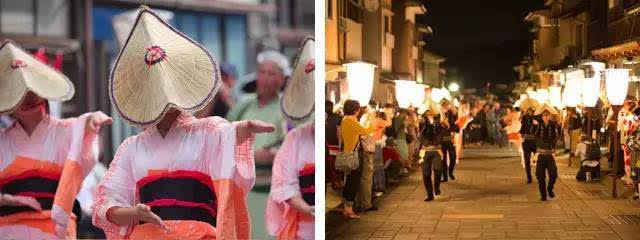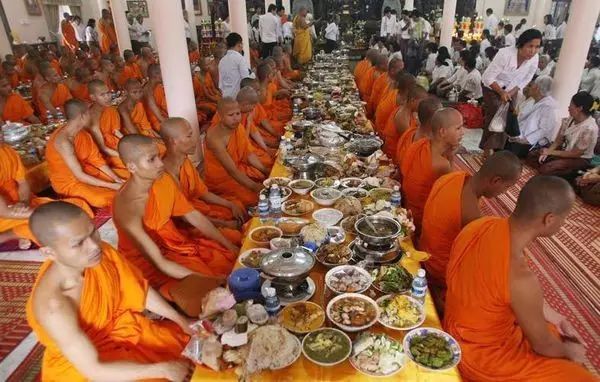In Japan, Obon Festival ranks only second to New Year's day in scale. It's said that to save the mother who has fallen into the hungry ghost way, a dharma meeting is held in which various foods are offered as offerings on the 15th of July (lunar calendar) of each year according to buddhist teachings. This activity was popular in ancient India and China, and it was carried out in Japan in Asuka period. Soon later, it spread widely. Now before or after August 13 in the solar calendar, every family sets up a soul niche, lights the fire of greeting soul and sending soul. Japanese attach great importance to Obon Festival. They set a three-day holiday and hold many sacrificial activities for it. Activities are more lively in the countryside. Families go to the cemetery to worship their ancestors, people who can’t go back will also entrust others to pay their respects. The ”Obon dance” is an indispensable part of Obon Festival. It has gone from expressing people's joy of escaping from sufferings to a folk dance with local ethnic characteristics. On warm summer nights, the whole village dances in a big circle to the sound of a big drum. In this unique way, they comfort the dead and cherish the present happy life, which has become a unique cultural landscape in Japan.
日本 盂兰盆节 在日本,"盂兰盆节"是规模仅次于元旦的盛大活动,据传说是为了拯救陷入饿鬼道的母亲,按照佛教的教义,在每年的7月15日(阴历),以各种食品为供品而进行的法会。这个活动曾在远古的印度和中国盛行,日本则是从飞鸟时代才开始进行的,后来传播得很广泛。现在阳历的8月13日前后,家家都设置魂龛、点燃迎魂火和送魂火,已成为日本祭奠祖先特有的活动。日本非常重视"盂兰盆节",节日期间放假三天,并有组织进行祭祀活动。在乡间活动更为热闹,家家户户到墓地祭祖,外出不能回来祭祖的人也会委托别人代为祭奠。"盂兰盆节"自然不可缺少的是盂兰盆舞,它由表达人们脱离苦难的喜悦,变成了如今具有各地民族特色的民间舞蹈了。在夏天温暖的夜晚,和着大鼓的咚咚声,全村子的人们围成一个大圆圈翩翩起舞,热闹非凡。他们用这种独特的方式,告慰死去的亡灵,珍惜眼前的幸福生活,成为日本特有的文化景观。

Every November 2 is the Tomb-sweeping Day of Mexico. Every family prepares special "bread for the dead", skull-shaped sugar and food or alcohol the deceased loved as a sacrifice to visit the graves. People dress in costumes, wear masks handed down from their ancestors and sing and dance to the spirits of their dead ancestors. Legend has it that this comes from the Indian customs. After the ceremony, the whole family spreads cloth in front of the tomb, sits on the ground, lights candles, eats and drinks, sings and dances all night long. There are also some people dressing as skeletons and ghouls to take part in the spectacular parade. Another famous tradition is that holiday revelers place a living person in a coffin and hold a mock funeral. The time of grave sweeping varies from region to region, some during the day and some at night.
墨西哥 亡灵节 每年11月2日为墨西哥的“扫墓节”,家家为死去的人扫墓。去时,准备特别的“亡人面包”、骷髅形糖块和已故亲人爱吃的食物及烟酒,作为祭祀供品。人们穿着奇装异服,戴上祖辈相传的假面具,对着先人的亡灵又唱又跳。相传这源自印第安人的风俗。举行仪式后,全家人在墓前铺上布,席地而坐,点上蜡烛,边吃喝,边歌舞,作为守灵,通宵达旦。有的人装扮成骷髅和食尸鬼参加的壮观游行。还有一种著名的传统,就是节日狂欢者们把一个活人装进棺材,举行一个模拟的葬礼。但各地区扫墓的时间不同,有的地区在白天,有的在晚上。

France's "all souls' day" is also known as "all saints' day", "the festival of the holy spirit". It's one of the Christian festivals and celebrated on November 1 every year. The French has one day off for this festival. Originally, the festival was dedicated only to saints who had been martyred, but later it was expanded to honor all "saints" who had been saved. It is customary for people to go to the cemetery to pay their respects to their deceased relatives or to remember those who have died in the service of their country. The French grave mainly by dedicating flowers (sending chrysanthemums in general), but the green pine and white paper flowers which are widely-used in the east are rare in France. Every year, the Paris commune monument and a dozen anti-fascist memorials near the cemetery in Paris are the places where the greatest number of mourners pay their respects to. Flowers are paid to the martyrs surrounded the monument.
法国 万灵节 法国的"万灵节"亦称"诸圣瞻礼",又称"圣灵节",是基督教节日之一,日期为每年的11月1日。这一天,法国全国放假1天。最初,该节仅为纪念殉道的圣者,后逐渐扩展到纪念所有得救的"圣徒"。民间的习惯是人们到墓地去,凭吊已故的亲人,或缅怀为国捐躯的先烈。法国人扫墓主要是奉献鲜花,而且以菊花居多,很少看见东方习惯用的青松翠柏和白色的纸花。每年位于巴黎公墓不远的巴黎公社纪念碑和十多个反法西斯纪念碑,是凭悼者最多的地方,人们向烈士献上的鲜花布满了纪念碑的周围。

According to Cambodian tradition, the day of the dead is held on October 1 solstice 15 of the buddhist calendar each year for a total of 15 days, making it the longest tomb-sweeping day in Asia. During the festival, at about 4 am every day, believers gather in the hall of the buddhist temple with folded hands, small wads of glutinous rice, cakes, bananas and candles. The sound of the monks' chanting drags them along. Cambodia's royal-palace-held "day of the dead" ceremony is much more solemn than the folk. On the first day of the ceremony, the eminent monks chant sutras at the Financial Palace of Devi Veni. The next day, the senior monks have to arrive at the palace before 4 a.m. to chant the sutras until 10 a.m., after which the elders arrange for the monks to eat. On the afternoon of the third day, the eminent monks recite the sutras for the late king until the early morning of the following day. On the fourth day, members of the royal family hold a ceremony with civil and military officials to respectfully invite eminent monks to recite sutras and pray for the late king to ascend to heaven as early as possible. On the last day of the festival of the dead, people in some parts of Cambodia will hold buffalos RACES in the village, which are as exciting as the F1 RACES. At the same time, the fifteenth day is the last and most important day of the festival of the dead. During the day everyone goes to the temple to give alms to the monks, and at night everyone goes back home to hold a big family worship ceremony.
柬埔寨 亡人节 根据柬埔寨的传统,亡人节在每年的佛历10月1日至15日举行,共进行15天,是亚洲最长的清明节。每天凌晨4点左右,善男信女们还要拿着捏成一小团一小团的糯米饭、糕点、香蕉、蜡烛等放在盘中,聚集在佛寺大堂,双手合十,听僧侣诵声音拖得长长的招魂经。柬埔寨王宫举行“亡人节”仪式则要比民间隆重得多。仪式第一天,高僧们在狄卫威尼财宫诵经。第二天,高僧们必须在凌晨4点钟之前到达王宫,诵经至早上10点,然后由长老安排僧侣们进食。第三天下午,高僧为已故国王诵经直至翌日凌晨。第四天,王族成员与文武官员举行仪式,恭请高僧诵经,祈求已故国王早登极乐世界。亡人节节期的最后一天,柬埔寨一些地区的人们还会在村里举办水牛赛跑,其精彩程度堪比F1大赛。同时,第十五天作为“亡人节”的最后一日,也是最重要的一天,白天大家都到寺里去给僧侣布施,晚上各自回家举行大家庭的祭拜仪式。

Translator: Yao Jialing
Time: 2019-4-6

